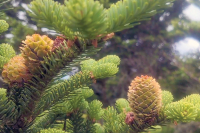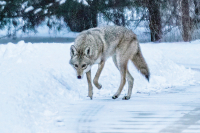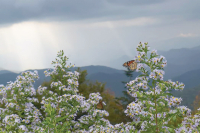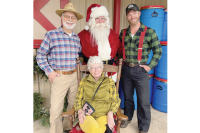A bird’s-eye view: Photographer publishes aerial views of WNC’s highest peaks
 If Garrett Fisher had his way, he’d live on the side of a mountain with a glacier as his next-door neighbor.
If Garrett Fisher had his way, he’d live on the side of a mountain with a glacier as his next-door neighbor.
Some people might consider his Wyoming home, located at 5,633 feet above sea level, to be close enough, but Fisher craves more elevation than that. So, he satisfies his thirst for altitude with aviation.
When it all clicks — the art of the angle
 John MacLean will never forget his first photo shoot.
John MacLean will never forget his first photo shoot.
“I was 19 years old and it was at a meat packing plant in New Jersey,” he said.
Standing in the basement of the Cullowhee Methodist Church at Western Carolina University last Saturday, MacLean told two-dozen folks of the Sylva Photo Club about how he got into the business.
Through his eyes
 Pulling into his steep, gravel driveway, the first thing you notice about Gary Montanari are his numerous pets.
Pulling into his steep, gravel driveway, the first thing you notice about Gary Montanari are his numerous pets.
“I hope you like dogs,” he said, as several barks are heard from around the property.
The second thing you notice about Gary Montanari is that he has lived an extraordinary life.
Let it snow! Area photographers capture winter beauty in WNC
 For every degree of cold or inconvenience, wintry weather adds two of beauty. Members of Waynesville’s Lens Luggers photography club kept their cameras at the ready as below freezing temperatures and above-normal snowfall transformed Western North Carolina into a winter wonderland. We hope you’ll enjoy some of their favorite images and the stories of how they came to be.
For every degree of cold or inconvenience, wintry weather adds two of beauty. Members of Waynesville’s Lens Luggers photography club kept their cameras at the ready as below freezing temperatures and above-normal snowfall transformed Western North Carolina into a winter wonderland. We hope you’ll enjoy some of their favorite images and the stories of how they came to be.
WCU will digitize historic Smokies photos
 Western Carolina University’s Hunter Library will produce a new digital collection of 2,000 items focused on the history of Great Smoky Mountains National Park with support from a $93,000 grant from the North Carolina State Library.
Western Carolina University’s Hunter Library will produce a new digital collection of 2,000 items focused on the history of Great Smoky Mountains National Park with support from a $93,000 grant from the North Carolina State Library.
“The park certainly has an amazing and well-cared-for archive, but it’s locked away,” said Anne Fariello, associate professor of digital initiatives with Hunter Library. “We will be digitally preserving and increasing access to material that is important, not only to the development of the park, but also to the region.”
Take only pictures, leave only footsteps: Outdoor photographers hone the craft of capturing the Smokies
 They stood in a line, trigger fingers poised, eyes fixated on the target.
They stood in a line, trigger fingers poised, eyes fixated on the target.
It was early morning, and the predawn sun had not yet peaked over the tops of the eastern range. An antlered male elk had his head down, buried in the tall, dew-covered grass, oblivious to the stakeout at the far edge of the meadow.
Photography stands out among a mixed bag of interest
Putting all of Ed Kelley’s interests in separate, tidy little boxes just doesn’t work.
There’s no way to separate Ed from Ed’s photography; or Ed’s photography from nature; or nature from Ed’s philosophy. There is also Ed Kelley the artist, the musician, the businessman, the husband, the father and the hiker.
When you approach one you get them all – not wrapped into a neat, tidy package but more like a large balloon half-filled with water, and as soon as you feel like you have your hands around the “real” Ed, the water shifts and Ed flows effortlessly, knowledgably and comfortably into another aspect of the balloon.
According to Kelley, he was a teenager before he began to discover the natural world that surrounded him in Haywood County and across Western North Carolina.
“I was 15 or 16 when I hiked to the top of Mt. Pisgah with a friend who was in the Boy Scouts. I was blown away by the view. All the years I had lived here and I had never seen this,” said Kelley, who owns Ridge Runner Naturals Gallery/Studio on Main Street in downtown Waynesville with his wife, Jo, a painter. The studio/gallery is adorned with Jo’s and Ed’s original artwork, including many examples of Ed’s nature photography.
Kelley said not long after that experience he got his drivers license and more and more trailheads in the area became accessible. But, he said a major shift occurred when he was a music major at Mars Hill College.
“They had what were called ‘mini-mesters’,” Kelley said. According to Kelley, a mini-mester was about a month-long class between the traditional fall and spring semesters.
“They had a backpacking class, and I signed up,” he said. “It was the first time I had ever been in Shining Rock Wilderness. We had to bushwhack from (U.S.) 276 up to Shining Rock. Then we hiked over to Sam’s Knob and back. We were out there for a couple of nights and it was awesome.”
Not long after that trip, Kelley nixed the music program at Mars Hill and enrolled in Forestry at Haywood Community College. That just served to cement his connection to the out-of-doors.
“We were in the field all the time,” Kelley said. “We had class in the woods; we would cruise timber or learn tree identification and there, I met a good friend who had the same kind of drive for the outdoors that I did.
“We both wanted to learn and see more and more. We went on lots of bushwhacking trips together. We would just get the maps out and say – look we can go from here to here – and we would set out.”
Kelley said there is a good reason his business was named the “Ridge Runner.”
“When we would get the maps out we would look at the ridges. The ridges are the connectors. We didn’t know if there would be trails or not but we knew we could follow the ridges.”
Second nature
Kelley said his attraction to photography predated his hiking addiction.
“I remember being in Washington, D.C., when I was in the seventh grade. I had this little box camera and I went all over town taking pictures,” he said.
“Not long after that I bought an old Canon FX from a photographer friend of the family. It was completely manual. I had a 50mm, a 125mm and a 28mm wide-angle lens and I took that camera with me everywhere. If I was hiking it was in my backpack,” Kelley said.
Looking back, Kelley said he is glad that he learned about photography from his old manual Cannon.
“I learned about light and aperture and shutter speed because all of that had to be done manually. It’s ingrained in me now, and when I go out I can concentrate on the composition of the photograph,” he said.
“Sometimes, now, I will hike to a specific spot at a specific time just to get one certain photograph. I’ve been there before and I’ve seen the scene and I know what time to be there for the best light,” Kelley said.
“Of course there are other times when I just grab my camera and head out to see what I might find.”
Asked to rank light, equipment, subject matter and composition or eye in some sort of photography hierarchy, Kelley said he felt the number one consideration was lighting.
“Everything else being equal, lighting will make or break a photograph,” Kelley said. “The best subject in poor lighting will result in a poor photograph, where a somewhat mundane subject in perfect lighting can produce an exceptional photo.”
Kelley ranked composition — being able to see in your mind’s eye what the finished photo will be, second. He ranked subject third and equipment fourth.
“There is so much decent photographic equipment out there today, that if you learn about light and shutter speed and aperture, and composition you’ll be able to get good photos.”
His favorite times of day to shoot are dawn and dusk.
“The light is just so much warmer then – it kind of embraces the subject instead of just lighting it.”
His favorite season is winter. ‘Because of the lower angle of the sun, you get that warm light for a longer period of time.”
A perfect storm
Kelley thinks the woods and mountains and balds are great. And he believes people can’t help but benefit spiritually and physically by spending time out doors. And for him, adding photography to his walks in the woods just increases his enjoyment. It nurtures his artistic spirit as well as his physical and mental wellbeing.
“I need that balance in my life,” Kelley said.
To see what that balance looks like go to www.edkelley.com.
Teaching photography at the old Whittier school
By Josh Mitchell • Staff Writer
J.R. vanLienden grew up in a frame shop and used to promise himself he would never get into the field of photography.
Now he has purchased the old Whittier elementary school built in 1936 to operate as a retreat for photographers from around the country to learn about photography.
Vanlienden, clad in workshop overalls, speaks very fast and said his attention deficit disorder doesn’t allow him to have a favorite photographic subject.
After taking family portraits on the beach for 15 years in Sarasota, Fla., vanLienden decided it was time to try photography in the Great Smoky Mountains.
Located at the base of Smoky Mountains National Park and in the rustic railroad town of Whittier, the school is an ideal setting for photographers to get away from it all and improve their craft.
Workshop attendees spend part of their time getting hands on instruction from professional photographers and can also take off on their own to explore the nationalpark and take some pictures.
The school, Smoky Mountain Learning Center, hosts different workshops, ranging from three to five days, put on by him and other professional photographers. The goal is for the school to be the new “photography mecca” in the mountains.
It will become the largest photo gallery in the region, he said. The school offers a feeling of learning while being able to enjoy the surrounding mountains, he added. With full production and framing facilities the school provides a romantic setting to learn photography. The long hallways are lined with large photographs taken by vanLienden, and the former classrooms provide learning spaces.
The stage of the school’s auditorium is filled with pictures vanLienden has taken.
He has taken some stunning shots of the Smoky Mountains, including waterfalls and streams.
Nature photography is not all he does though. He does a lot of portraits, and particularly has a passion for pictures of babies and their mothers.
One eye-catching picture was of a large nude African American man with his baby sitting down on his back.
While he was in Florida he made a living taking pictures of families on the beach but said he had to give that up because his four children were growing up on him too fast.
So he decided he would move the family to the Smoky Mountains region. Gatlinburg was the first idea, but he couldn’t find the land he needed to open his studio.
On the way back home to Florida he picked up a real estate magazine and saw that the school and five acres were for sale for $500,000.
His wife didn’t think it was such a good idea after seeing the condition of the school, but vanLienden convinced her that it could be fixed up.
Now that the school has been rehabbed, the next step is to expand the photography school. Plans are in the works to bring 25 to 50 cabins to the property that workshop attendees can stay in them.
He also plans to open a daycare in a section of the school. And in the future there may be workshops for subjects other than photography including cooking, woodworking and arts, he said.
Peace in the valley: Franklin photographer Bill Lea captures beauty and history of Cades Cove in new book
For nature photographer Bill Lea, Cades Cove is heaven on earth.
A hard day’s work
On Earth’s Furrowed Brow: The Appalachian Farm in Photographs by Tim Barnwell. W. W. Norton, 2007. 224 pages.
For a time my father’s love affair with decaying barns and farmhouses became something of a family joke. If he decided to take a back road to get anywhere, those of us in the car with him knew that we were in for a long ride. Every time we would pass some swaybacked, gray barn with half the tin roof missing or a farmhouse with a tumbledown chimney and windows like gray, broken teeth, my father would slow or even stop the car. Sometimes he would reach for his camera or sketchbook — he was both an amateur photographer and painter — and we would inwardly groan. We knew then we might be stopped for a while.
“They’re disappearing,” my dad would say each time. “All these old buildings are crumbling away.”
Some of his best paintings were of old barns and rural scenes. Hanging above me as I write is one of the first watercolors he ever attempted, a painting of a barn on my grandfather’s farm. At one point my father owned his own small farm in Traveler’s Rest, S.C., and he also made several paintings of that property.
At least once he’d gone to one of these derelict buildings and collected timber from them, incorporating the weathered beams and siding into his house. He collected small farm tools as well — hammers and awls and scythes and mauls, and knew how they were used.
At the time my siblings and I were bored with his side trips and snapshots. We’d come of age in rural North Carolina, in the great tobacco country around Winston-Salem where we were surrounded by hills and barns and farmhouses. Some of those buildings looked ancient indeed, and some were already disintegrating into dust and splinters, but our father’s warnings still seemed premature. Surely the barns were as an immutable part of the landscape as the red clay fields or the mules and tractors that shaped them.
We were wrong, of course. The tobacco fields of Yadkin County gave way to grapes and wineries. The barns fell apart or were pulled down to make room for housing tracts, condominiums, and suburbs. A good number of Americans have never seen a mule in the flesh, and tractors are used as much for mowing as for plowing.
For most of his adult life, Tim Barnwell has documented through photographs and oral histories this same trend in Southern Appalachia. In his latest book, On Earth’s Furrowed Brow: The Appalachian Farm in Photographs (ISBN 978-0-39306267-0, $35), Barnwell brings together more than a hundred of the black-and-white photographs of rural Appalachia he has taken over the past 25 years.
Although this volume contains pictures of buildings, abandoned cars, apple trees, and snowy pastorals, the majority of Barnwell’s stunning photographs are of farmers, their friends and family members.
Here is Kella Buckner with his mule, pulling a sled of rocks in Madison County; here are families putting up hay. There are shots of youngsters playing on a tire swing and attending a church social. Here are photographs of a hog killing, of beans being shelled, of tomatoes and other produce picked from gardens, of cane being ground at a molasses mill.
Doubtless everyone will find certain photographs in this book that they prefer over some of the others. My own particular favorite can be found on page 28. Titled “Doug Messer, resting from tilling field, 2003,” this photograph shows Mr. Messer hunkered down at the edge of a muddy field. In one hand he holds a cap with what appears to be a military logo. In his other he clutches a rag with which he has clearly just wiped the sweat from his face. He sits with his face and body in profile to the viewer. His face, a picture of heat and exhaustion, has as many gullies and furrows as the land around him.
His eyes are nearly closed; a hank of hair falls across his brow. His mouth hangs half-open as if he can’t quite catch his breath. Around his waist he wears a brace. In the background stands the tiller, the tool with which Messer has worked the field. The photograph reminds us, if we need reminding, that it still takes a man to work the machine that works the field and that the man will often take a beating from the work.
In addition to the photographs, On Earth’s Furrowed Brow includes more than 30 pages of oral histories taken from conversations between Barnwell and the people he photographed. We meet Alton Price, who has never ventured more than 75 miles from his home. We meet Plato Worley, whose father drank a cup of hot water for breakfast, water throughout the day, and a glass of milk with supper; Worley remembers when he finally persuaded his father to try an orange soda. We meet person after person who grew up in a family of 10 children or more.
What is refreshing about On Earth’s Furrowed Brow is Barnwell’s refusal either to romanticize farming or to regard our region’s past with melancholic nostalgia. That farming is tough, body-breaking work we can see in the faces of those who spent themselves on the land. And while there is a sense of nostalgia here, of a people and a way of life giving way to new ways and irrevocable time, Barnwell’s photographs give us a feeling of hope for our own future. We sense that we, like these people, will face our own struggles, that like them we will find our own solutions and make our own peace with change.









